Forager Build Guide
BOM
Parts included in the kit
| Part name | Qty | Remarks |
|---|---|---|
| Forager PCB (left, right side) | 2 | Fully assembled |
| Case | 2 | 3D printed with black PLA |
| Tenting feet | 4 | 3D printed with black PLA |
| Screws | Black countersunk M2x4 screws (with spare screws) | |
| Rubber feet |
Additionally required parts
| Part name | Qty | Remarks |
|---|---|---|
| Choc V1 switches | 34 | |
| Choc V1 keycaps | 34 | |
| LiPo 1S 3.7V battery | 2 | Optional with a JST ACH connector |
| Screwdriver | Torx T6 |
Battery
You need a Lipo 3.7V (1 cell) battery.
The battery should have the max. dimensions to fit in the case.
Width: 15mm Length: 34mm, Thickness: 3mm
The board has a JST ACH connector or if your battery does not have the right connector, your can solder the two cable direct on the PCB.
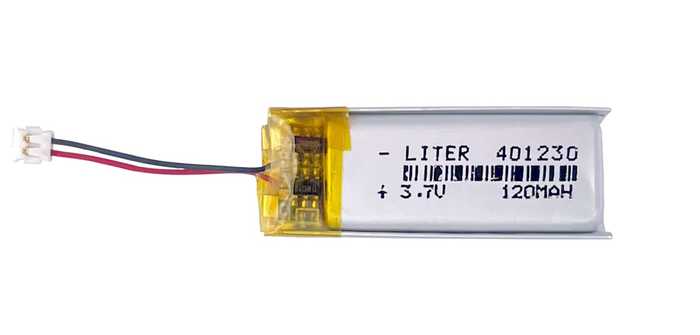 401230 Lipo with 120mAh and a JST ACH connector
401230 Lipo with 120mAh and a JST ACH connector
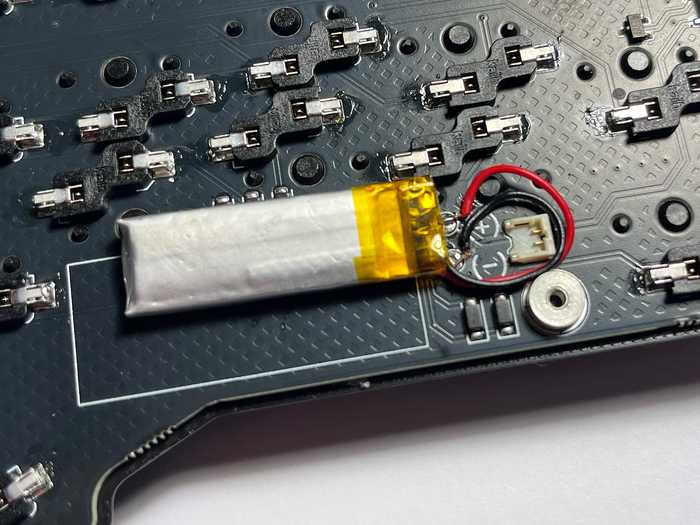 Lipo battery without JST connector, with cables directly soldered to the PCB.
Lipo battery without JST connector, with cables directly soldered to the PCB.
Red = (+) , Black = (-)
Where to buy
You can search for "301230 lipo" or "401230 lipo".
Below is a handpicked list of compatible batteries.
- Aliexpress (Int) - Lipo 120mAh with JST ACH connector *
- Little Keyboards (US)
- Powercells (DE) - JST-P connector must be removed
- Amazon (DE) - 301230 110 mAh withou connector *
Screws
Use a Torx T6 screwdriver and tighten the screws carefully to avoid damage.
The set includes some spare screws.
Assembly
-
Check that you have all required parts
- Image with all parts
-
Attach or solder the battery cable to the PCB and secure the battery with the double-sided adhesive tape. See above
-
Insert the PCB into the bottom of the case. Start with the USB connector and then push the overlying side down. Tighten the 5x screws. Ensure that the battery cable is not trapped between the case and the soldering nut.
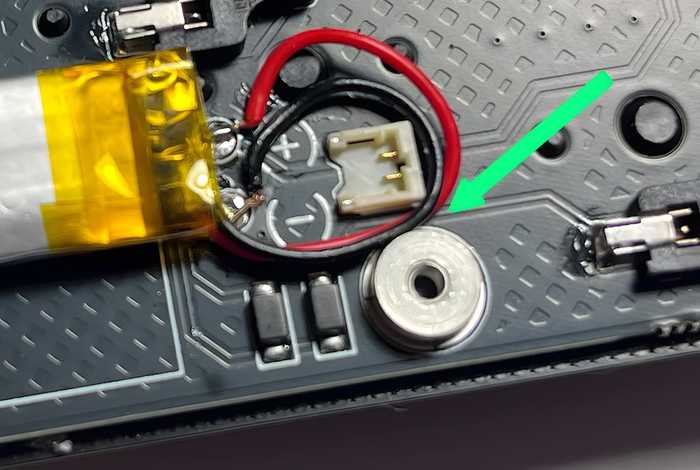
-
Place the top plate on the on PCB.
Take a choc v1 switch and check that the 2 metal pins are straight.
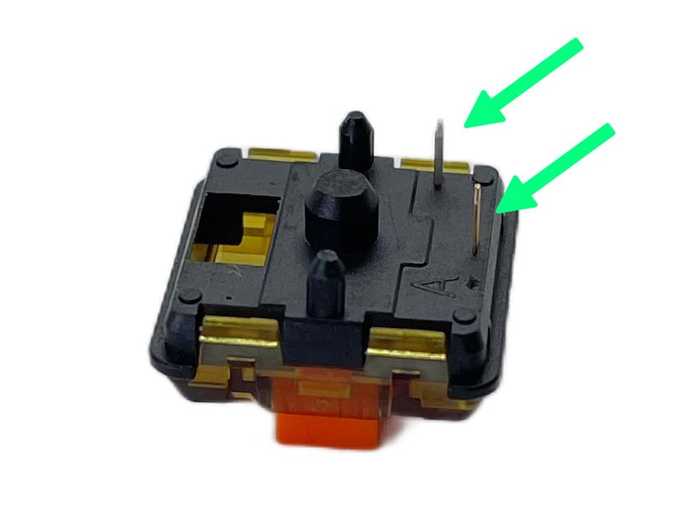
Check the orientation before inserting the switch. Insert the switch into one of the outer cut-outs.
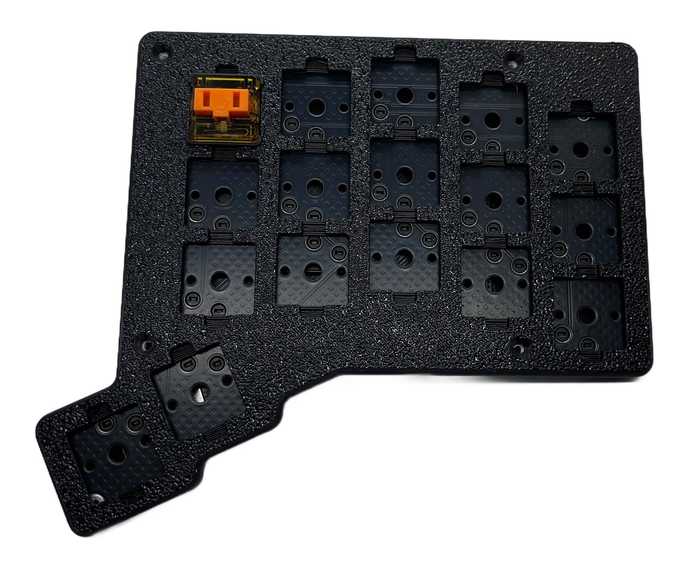
-
Repeat the last step for the remaining 3 outer switch cut-outs and then proceed with the remaining switch cut-outs. This will align the top plate in the correct position.
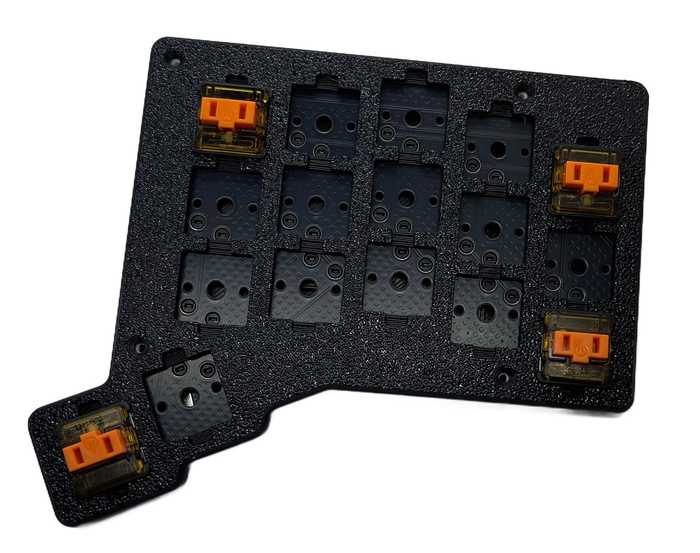
-
Screw the 4x screws into the top plate.
Typing Test
With Forager fully assembled, it's time to test it out!
The QMK Configurator pag gives you visual feedback.
Default keymap
The Forager ships with the following default keymap:
Keymap image created with keymap-drawer.streamlit.app
ZMK Studio
With ZMK Studio you can change the keymap without flashing a new firmware.
The pre flashed firmware has ZMK Studio enabled.
- Connect the centre half to your computer using a USB cable.
- Open the ZMK Studio website, or download the latest release of the cross platform application.
- To unlock the keyboard, press the studio_unlock key (first column, second row) in the
adjlayer.
To access theadjlayer, hold the sym and the num key. - Now you can change the keymap to suit your needs. Not all ZMK features are supported by ZMK Studio. More information here.
Wireless
ZMK will automatically start advertising to allow new hosts to connect. From your computer, go to the bluetooth preferences and add a device. You should see a device named "Forager" in the list. Click that item to connect. Once connected over bluetooth, you should be able to start typing.
To use more than one host/device with you Forager, you'll need to use different profiles to manage the connection/communication with each device. To learn more, read up on ZMK's bluetooth feature.
[* affiliated links]


